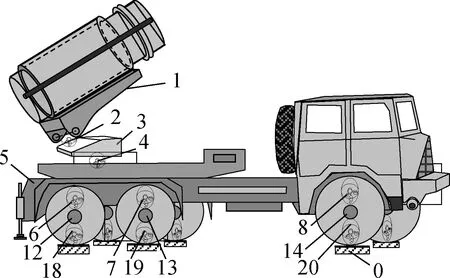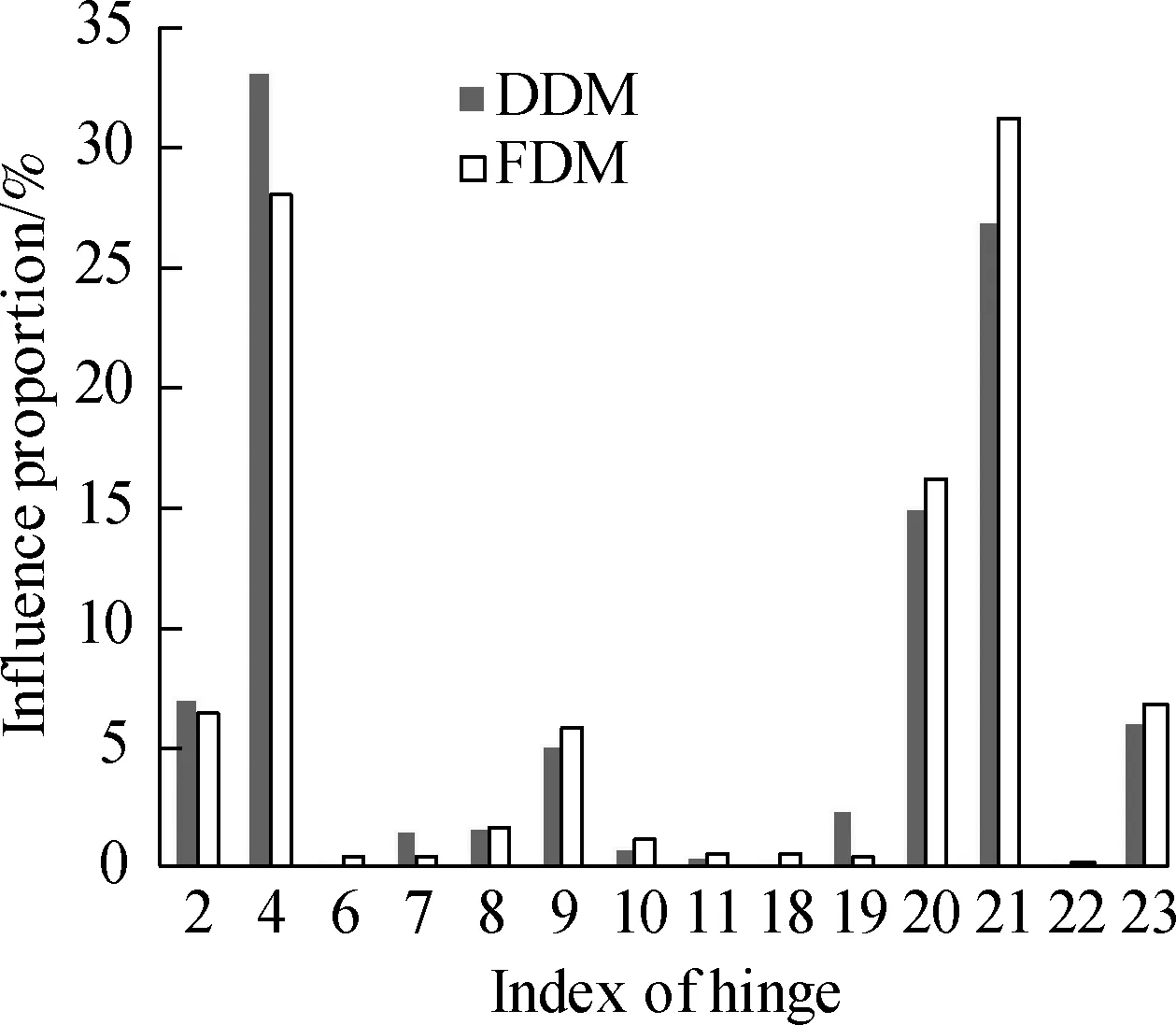Novel sensitivity analysis method and dynamics optimization for multiple launch rocket systems
2022-04-19TuTianxiongWangGuopingRuiXiaotingMiaoYunfei
Tu Tianxiong Wang Guoping Rui Xiaoting Miao Yunfei
(Institute of Launch Dynamics, Nanjing University of Science and Technology, Nanjing 210094, China)
Abstract:This study establishes the launch dynamics method, sensitivity analysis method, and multiobjective dynamic optimization method for the dynamic simulation analysis of the multiple launch rocket system(MLRS)based on the Riccati transfer matrix method for multibody systems(RMSTMM), direct differentiation method(DDM), and genetic algorithm(GA), respectively.Results show that simulation results of the dynamic response agree well with test results.The sensitivity analysis method is highly programming, the matrix order is low, and the calculation time is much shorter than that of the Lagrange method.With the increase of system complexity, the advantage of a high computing speed becomes more evident.Structural parameters that have the greatest influence on the dynamic response include the connection stiffness between the pitching body and the rotating body, the connection stiffness between the rotating body and the vehicle body, and the connection stiffnesses among 14#, 16#, and 17# wheels and the ground, which are the optimization design variables.After optimization, angular velocity variances of the pitching body in the revolving and pitching directions are reduced by 97.84% and 95.22%, respectively.
Key words:Riccati transfer matrix method for multibody systems; multiple launch rocket system; launch dynamics; sensitivity analysis; optimization design
With advantages of a high firing speed, large firing area, long firing range, excellent mobility, and heavy firepower density weaved in a short time, the multiple launch rocket system(MLRS)has found its place in modern warfare.Theoretical and experimental results of the launch dynamics show that reducing the initial perturbation of the rocket can significantly improve the firing accuracy of the MLRS.The establishment of an accurate launch dynamics model and an appropriate dynamics method is needed for analyzing the launch dynamics process of the MLRS.
The launch dynamics of the MLRS is a new subject that studies the force, motion law, and control process of the MLRS during launch and then studies the theory, technology, and test methods of force, motion, and control.Based on the transfer matrix method of a linear multibody system, Rui et al.[1]established the launch dynamics model of the MLRS, solved the difficult problem of calculating the vibration characteristics of a rigid elastic coupled multibody system of the MLRS, and studied the influence of random factors such as gusts on the launch process of the MLRS.Some researchers explored the MLRS’ vibration control system[2-3], optical lever test technology[4], and the non-full tube firing scheme[5].
An efficient multibody dynamics method is important for multibody systems like the MLRS.In 1989, Rui et al.[6]developed the transfer matrix method for multibody systems(MSTMM), which avoided the need for global dynamic equations.Instead, the involved matrices have a low order, and the setup of the overall transfer equation is highly programmable.The Riccati transfer matrix method for multibody systems(RMSTMM)was developed by introducing the Riccati transformation in the MSTMM, i.e., dividing state vectors into two parts, to improve the numerical stability of the MSTMM[7-8].
A sensitivity analysis is needed to analyze the influence of structural parameters.Commonly used sensitivity analysis methods include the finite difference method(FDM), adjoint variable method(AVM), and the direct differentiation method(DDM).The DDM has many characteristics, such as arguably the most conceptually straightforward sensitivity analysis method, high numerical stability, insensitivity to the parameter perturbation, and easy application for different structural problems[9].RMSTMM is a highly programmable algorithm.The disadvantage of the complicated deduction of sensitivity analysis equations can be avoided by combining the DDM and the RMSTMM.
The genetic algorithm(GA)is a common algorithm for the dynamic optimization of multibody systems.GA is first produced by Professor Holland in 1973[10].Many kinds of hybrid genetic algorithms have been researched by many.GA has been used for the dynamic optimization of the milling robot[11], knee rehabilitation[12], 6-DOF vibration isolation[13], and human-machine coupling[14].
This paper establishes the launch dynamics model of the MLRS and carries out the launch dynamics simulation calculation using the RMSTMM initially.A novel sensitivity analysis method for the launch dynamics of the MLRS is developed, which is based on the RMSTMM and DDM.By the proposed method, the sensitivity of some structural parameters of the MLRS is calculated, and factors influencing the launch dynamic response of the MLRS are analyzed.The multiobjective dynamics optimization of the MLRS is carried out by combining the sensitivity analysis results and GA.Dynamic responses of the pitching part of the MLRS are considerably reduced.
1 Launch Dynamics Modeling and Simulation Calculation of MLRS Based on RMSTMM
1.1 Launch dynamics model of MLRS
According to the natural properties of various components of the MLRS, a nonlinear dynamic model for a typical MLRS is shown in Fig.1(a), which consists of body elements, hinge elements, and boundary points.Body elements and hinge elements are numbered uniformly.Fig.1(b)presents the topology of the MLRS model, describing the relationship among the state vectors of elements and the transfer directions.

(a)
1.2 Launch dynamics analysis of MLRS based on RMSTMM
The state vector of each connection end, e.g., pointP, is divided into two complementary parts.One part includes the acceleration and angular acceleration.The other part includes internal forces and torques, namely
(1)
The state vector of the connecting pointPcan be transformed by the Riccati transformation
za,P=SPzb,P+eP
(2)
whereSPis the Riccati transfer matrix of pointP, which is a 6×6 matrix, andePis the column matrix corresponding to the nonhomogeneous term.
Transfer equations of the elementjare
zj,O=Ujzj,I+fj
(3)
whereUj,fjare the transfer matrices of elementj, which can be obtained by the transfer matrix library.
The inertial measurement unit(IMU)was used to test the attitude angular velocity of the pitch part.Fig.2 shows the comparison between the simulation results and test results of the MLRS.The simulation results of the proposed method agreed with the Lagrange method and test results, proving that the launch dynamics model can accurately reflect the launch dynamics of the MLRS.

(a)
2 Sensitivity Analysis of MLRS Based on the DDM
2.1 Sensitivity analysis model of the launch dynamics of the MLRS
The stiffnesses of each part of the MLRS are chosen as the design variables, denoted asw, and the objective functions are the mean value and variance of the angular velocity of the pitching part when the rockets exit the muzzle, namely
(4)
(5)
According to Eq.(5), the key to calculating the sensitivity of the objective function is to calculate the sensitivity of the dynamic response of the MLRS.
2.2 Sensitivity analysis method for the MLRS
In RMSTMM, the differentiation ofωy,ωzwith respect to the design variablewcan be obtained by the differentiation of the state vectorzas follows:
This proposed sensitivity analysis method has several advantages, such as high programming, no need for global dynamic equations, no requirement of the differentiation of global dynamic equations.Fig.3 shows that the time consumption of the proposed method was much lower than that of the DMM based on the Lagrange method.As the body number increased, the computation time gap between the two methods became increasingly large.This indicated that the proposed method has the advantage of a lower computational time cost.

Fig.3 The comparison between simulation results and test results of the MLRS
2.3 Sensitivity analysis results of the MLRS
The influence proportion of the mean of the angular velocity computed by the two methods(DDM and FDM)can be seen in Fig.4, and the influence proportion of the variance can be seen in Fig.5.The FDM computes the influence proportion by giving each design parameter 0.1% disturbance.

(a)

(a)
According to the calculation results in Figs.4 and 5, the main factors that affect the launch dynamic response are hinge 2(connecting the pitching part and the revolving part), hinge 4(connecting the revolving part and the chassis), hinge 20, hinge 21, and hinge 23(connecting the wheels and the ground).
3 Dynamics Optimization of the MLRS


Tabs.1 and 2 show the optimization results obtained by the GA.

Tab.1 Optimization results of design parameters MN·m/rad
It can be seen from Tab.2 that the variance of the angular velocity when the rocket exits the muzzle in both directions has been reduced significantly, with reduced rates of 97.84% and 95.22%.By optimizing these five parameters, the dynamics response of the pitching part of the MLRS is reduced significantly.

Tab.2 Optimization results of the objective function
4 Conclusions
1)Based on the RMSTMM, the launch dynamics model of the MLRS was established, and the launch dynamics simulation was carried out and validated by test results.
2)A DDM has been applied to the formulation for the sensitivity analysis of multibody systems, and a novel sensitivity analysis method for the launch dynamics of the MLRS was proposed.The proposed method has several advantages, such as low computation time cost, high programming, no need for global dynamic equations, and no requirement for the differentiation of global dynamic equations.Based on the proposed method, the main factors influencing the launch dynamic response of the MLRS are analyzed.
3)A multiobjective optimization method for the MLRS is developed.The optimization method yielded reduced rates of 97.84% and 95.22% for the variance of the angular velocity in different directions.The dynamics response of the pitching part of the MLRS is found to be significantly reduced.
杂志排行
Journal of Southeast University(English Edition)的其它文章
- Statistical analysis of nondestructive testing results of cast steel joints in civil engineering structures
- Detection of solar radio burst intensity based on a modified multifactor SVM algorithm
- Metrics analysis of tactile perceptual space based on improved NMDS for leather textures
- Short-term traffic flow prediction with PSR-XGBoost considering chaotic characteristics
- Contract stability and default risk control of pig farming in the company and farmer mode
- Finite rate of innovation sparse sampling for a binary frequency-coded ultrasonic signal
